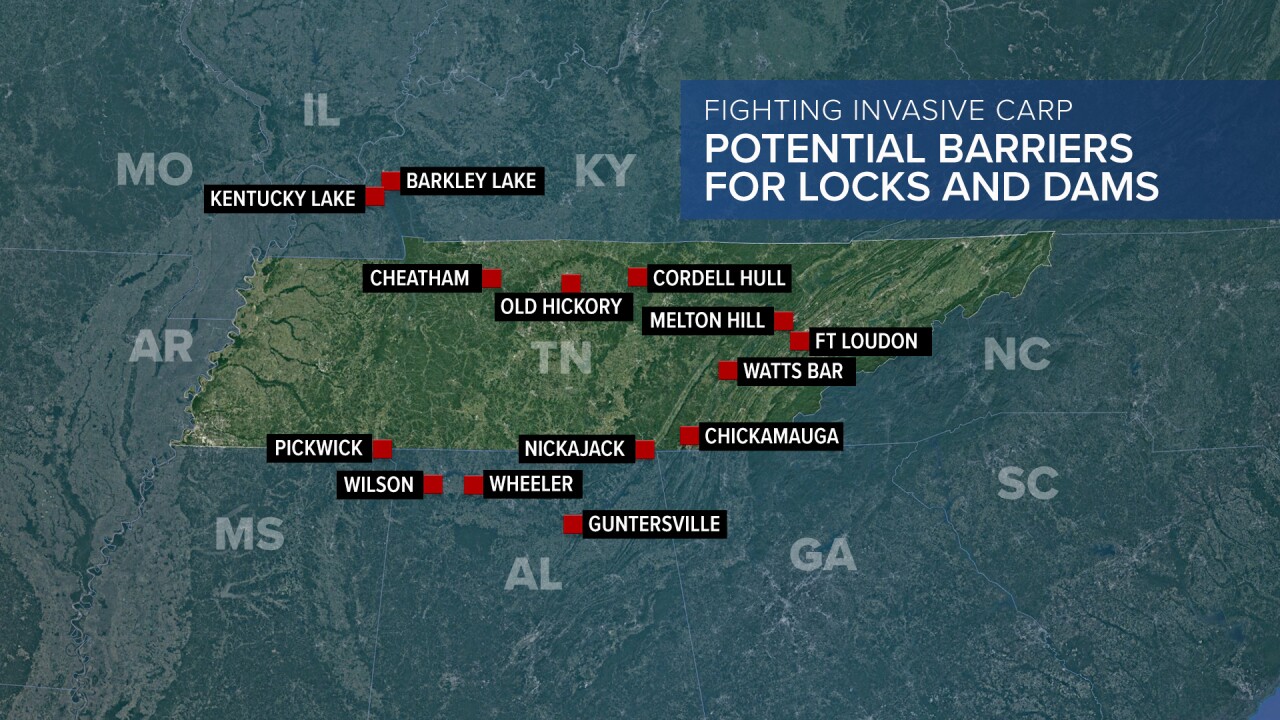OLD HICKORY, Tenn. (WTVF) — There's something in the water that's been worrying engineers and scientists for decades. It's a specific breed of fish that aren't native to Tennessee waterways, and that's a big problem.
"These fish are invasive, and they compete for food and water, space and habitat with the native fishes," said Cole Flatt, a biologist for the U.S. Army Corps. of Engineers. "You can see the invasive carp jump when you motor your boat by. They’re triggered by the sound that’s emitted in the water by the motor. And they’ll jump, and they can actually be dangerous and jump inside the boat."
Also previously known as Asian carp, this invasive carp species were accidentally released into the Mississippi River decades ago, and continue to migrate upstream.
"They do not have any natural predators. They grow really fast and can reproduce at alarming rates," said Flatt.
They're already a big problem at Kentucky Lake and Lake Barkley.
"That's where they’re most prevalent because they’re coming out of the Mississippi — so that's western Tennessee, the western Kentucky area. And then they move upstream to Nashville," said Flatt.
The invasive carp are able to travel from lake to lake the same way boats do — through navigational locks located at each dam.
"While the door is open, while the barges are locking through, it’s an opportunity for the fish to also transport through as well," said Veronica McCormack, the Chief of Environmental and Cultural Resource Section in the Project Planning Branch of the U.S. Army Corps. of Engineers.
This is why the Corps is launching a pilot program to study different deterrent methods they can set up around or inside the locks themselves. "It’s a logical place for us to put barriers because we can control it," said McCormack.
The Corps. of Engineers have a few ideas on how to do it:
- Underwater Acoustic Deterrent System (uADS) – consists of an underwater installed apparatus with speakers that produce various loud sounds to repel carp away from the lock or dam.
- Bio-acoustic Fish Fence (BAFF) – sends a curtain of bubbles, sound, and light from the riverbed to the water surface, which deters noise sensitive invasive carp from entering the lock chamber.
- Carbon Dioxide (CO2) Infusion – consists of a process infusing water with recycled CO2 gas to discourage the movement of invasive carp by avoiding the soda-like water.
- Electrical current barrier – consists of a barrier located along the waterway that emits an electrical current which doesn’t electrocute the carp, but repels them when they encounter the strong electrical field.

The Corps. of Engineers will pick 10 projects at a few of the dams on the Tennessee and Cumberland River systems. Whichever method proves to be the most effective against the invasive carp and harmless to the native fish, could become the standard. "We’d like to eradicate them as soon as possible," said Flatt.
It's all in the hope that a truly robust fish population can thrive once again.
"The worry is they’ll continue to spawn and grow and flourish in the Cumberland and Tennessee rivers so we’d like to stop that as soon as possible," said Flatt.
Before the pilot program can begin, the U.S. Army Corps. of Engineers is seeking feedback from the community on the environmental impact of this plan.
If you'd like to weigh in on the environmental impact, send an email to corpslrnplanningpubliccom@usace.army.mil no later than October 26, 2022. If you're unable to access an email account, you can send written comments to 110 9th Avenue South, Room A-405 Nashville, TN 37203-3817.
You can also call Kathleen McConnell at 251-323-2533 for more information about the NEPA process.
National Environmental Policy Act Process





